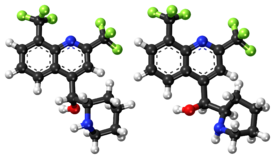
Back Meflokien Afrikaans مفلوكوين Arabic مفلوکین AZB Mefloquina Catalan Mefflocwin Welsh Mefloquin German Meflokino Esperanto Mefloquina Spanish Meflokviin Estonian مفلوکین Persian
 | |
 | |
| Clinical data | |
|---|---|
| Trade names | Lariam, Mephaquin, Mefliam, others |
| AHFS/Drugs.com | Monograph |
| MedlinePlus | a603030 |
| License data |
|
| Pregnancy category |
|
| Routes of administration | By mouth |
| ATC code | |
| Legal status | |
| Legal status | |
| Pharmacokinetic data | |
| Metabolism | Extensive liver; main metabolite is inactive |
| Elimination half-life | 2 to 4 weeks |
| Excretion | Primarily bile and feces; urine (9% as unchanged drug, 4% as primary metabolite) |
| Identifiers | |
| |
| CAS Number | |
| PubChem CID | |
| DrugBank | |
| ChemSpider | |
| UNII | |
| KEGG | |
| ChEMBL | |
| NIAID ChemDB | |
| Chemical and physical data | |
| Formula | C17H16F6N2O |
| Molar mass | 378.318 g·mol−1 |
| 3D model (JSmol) | |
| Chirality | Racemic mixture |
| |
| |
| | |
Mefloquine, sold under the brand name Lariam among others, is a medication used to prevent or treat malaria.[4] When used for prevention it is typically started before potential exposure and continued for several weeks after potential exposure.[4] It can be used to treat mild or moderate malaria but is not recommended for severe malaria.[4] It is taken by mouth.[4]
Common side effects include vomiting, diarrhea, headaches, sleep disorders, and a rash.[4] Serious side effects include potentially long-term mental health problems such as depression, hallucinations, and anxiety and neurological side effects such as poor balance, seizures, and ringing in the ears.[4] It is therefore not recommended in people with a history of mental health problems or epilepsy.[4] It appears to be safe during pregnancy and breastfeeding.[1]
Mefloquine was developed by the United States Army in the 1970s and came into use in the mid-1980s.[5][6][7] It is on the World Health Organization's List of Essential Medicines.[8][9] It is available as a generic medication.[4]
- ^ a b "Mefloquine (Lariam) Use During Pregnancy". Drugs.com. Retrieved 31 March 2019.
- ^ "Lariam 250 mg tablets - Summary of Product Characteristics (SmPC)". (emc). 3 April 2019. Retrieved 8 September 2020.
- ^ "Lariam brand of mefloquine hydrochloride tablets". DailyMed. Retrieved 9 October 2022.
- ^ a b c d e f g h "Mefloquine Hydrochloride". The American Society of Health-System Pharmacists. Archived from the original on 2015-12-08. Retrieved 27 Nov 2015.
- ^ Croft AM (April 2007). "A lesson learnt: the rise and fall of Lariam and Halfan". Journal of the Royal Society of Medicine. 100 (4): 170–174. doi:10.1177/014107680710011411. PMC 1847738. PMID 17404338.
- ^ Ravina E (2011). The evolution of drug discovery : from traditional medicines to modern drugs (1. Aufl. ed.). Weinheim: Wiley-VCH. p. 136. ISBN 9783527326693.
- ^ Farrar J, Hotez PJ, Junghanss T (2013). Manson's tropical diseases (23rd ed.). Oxford: Elsevier/Saunders. p. 569. ISBN 9780702053061.
- ^ World Health Organization (2019). World Health Organization model list of essential medicines: 21st list 2019. Geneva: World Health Organization. hdl:10665/325771. WHO/MVP/EMP/IAU/2019.06. License: CC BY-NC-SA 3.0 IGO.
- ^ World Health Organization (2021). World Health Organization model list of essential medicines: 22nd list (2021). Geneva: World Health Organization. hdl:10665/345533. WHO/MHP/HPS/EML/2021.02.
© MMXXIII Rich X Search. We shall prevail. All rights reserved. Rich X Search